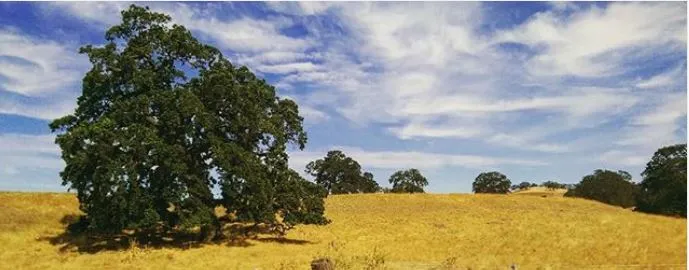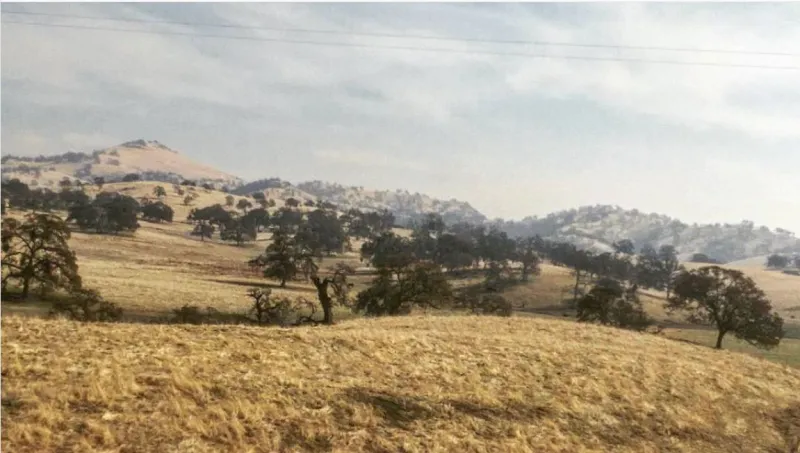Oak Woodland Management Plan
Background and Importance
Extending over vast areas of the state, hardwood rangelands are characterized by overstory canopy of hardwood tree species (predominantly oak) at least 10% cover, with an understory of annual grasses, forbs, and native perennial grasses at lower elevations, and intermixed with montane forests at upper elevations (Huntsinger and Fortmann, 1990; Standiford et al., 1996; Los Angeles County Oak Woodlands Habitat Conservation Strategic Alliance, 2011). Typically found at elevations between 200-5,000 feet (varying by species and location), California oaks also occur as components in desert plant communities and conifer-dominated forest ecosystems (Bernhardt and Swiecki, 2001). California has approximately 8.5 million acres of oak woodland, and 4.5 million acres of oak forest (Gamarn and Firman, 2006). With over twenty five native oak species, some of the dominant species include: valley oak (Quercus lobata), blue oak (Q. douglasii), interior live oak (Q. wislizeni), coast live oak (Q. agrifolia), and Engelmann oak (Q. engelmannii) (predominantly in southern California). Different species thrive in specific site conditions, precipitation levels, geographic locations, and at different elevations. For example, valley oaks (endemic to the state) are found in areas with relatively shallow water tables, predominantly found at elevations below 2,400 feet - with some exceptions (Bernhardt and Swiecki, 2001; Standiford, 2018), while blue oak woodlands occur on a wide range of soils, mostly below 3,000 to 4,000 feet, and across a wide gradient of precipitation levels (ranging from 10 to 60 inches annually) (Standiford, 2018). For more information on California's Oak Woodlands species specific characteristics, and habitat distributions click here.

Problem
Human impacts on oak woodlands have adversely affected oak dominated ecosystems causing significant habitat loss, as trees were cleared for more profitable sues such as: agriculture, rangeland "improvement”, urban expansion, industrial development projects, and/or fuelwood (Bernhardt and Swiecki, 2001). For example, conversion of valley oak woodlands to irrigated agricultural land uses has resulted in a significant decline of this habitat type (Standiford, 2018). In addition to this, the dynamics of residential expansion into the oak woodlands has led to habitat fragmentation, and loss of essential ecosystem services. Areas dominated by blue, valley, and Engelmann oak have been the mostly affected (Bernhardt and Swiecki, 2001). Conservation strategies should link restoration and management actions and recognize the widespread extent of oak dominated ecosystems, and their important ecosystem functions, and ecological values (Standiford et al., 1996).
Ecological Value
With approximately 80% of oak woodlands located on privately owned property (Kellogg et al., 2010), and primarily used for livestock production, hardwood oak rangelands deliver an array of socio-ecological benefits (Bernhardt and Swiecki, 2001). The low elevation oak woodlands of California's valleys and foothills provide habitat for over 300 species, and are thought to be among the most biodiverse broad habitat types in California, exhibiting higher species diversity levels than grasslands and irrigated agricultural lands (Staniford and Bartolome, 1997; Bernhardt and Swiecki, 2001; Stewart et al., 2008). In addition to this, oak dominated ecosystems play a critical role in preventing erosion (having an important role in soil development), while preserving water quality, regulating water flow, and maintaining watershed health (Standiford et al., 1996; Staniford and Bartolome, 1997; Bernhardt and Swiecki, 2001). Oak woodlands are also recognized for their aesthetic value and recreational functions, and are seen as valuable open space around residential development (Staniford and Bartolome, 1997; Stewart et al., 2008).
Relevant Legislation, Current Efforts and Management Strategies
The Oak Woodlands Conservation Act of 2001 (AB 242), recognizes the ecological value and multiple benefits stemmed from oak dominated ecosystems, and highlights the importance of protecting and preserving the health of these natural habitats (State of California Wildlife Conservation Board, 2017). In 2004, the California Environmental Quality Act (CEQA) was amended through SB 1334 (Public Resources Code Section 21083.4) to specifically address the impacts and mitigation of land development in oak woodlands (Los Angeles County Oak Woodlands Habitat Conservation Strategic Alliance, 2011). Since it is thought that a large coast live oak can sequester over 9 tons of carbon dioxide in 50 years, the Natural Resources Agency and California Air Resources Board (ARB) have started to mandate evaluating the impacts of oak woodland conversion on greenhouse gas emission (Los Angeles County Oak Woodlands Habitat Conservation Strategic Alliance, 2011).

Los Angeles County Oak Woodlands Conservation Management Plan
The Los Angeles County Oak Woodlands Conservation Management Plan (OWCMP) was drafted in 2011. The purpose of the document was twofold. On one hand it was set to provide input into the Los Angeles County General Plan update. On the other hand is was intended to meet the requirements of the California Oak Woodlands Conservation Act (AB 242). Some of the primary goals of the plan were to: preserve and develop a consistent policy for the management of oak woodlands; design restoration strategies; preserve, enhance, or restore sustainable oak woodland functions; plan approaches for dealing with loss of oak woodlands, and create opportunities for recovery. Other objectives of the plan were focused on: offering incentives for voluntary conservation of oak woodlands on private property; quantifying the economic and environmental benefits of oak woodland preservation; providing funding to willing landowners to purchase oak woodlands and/or conservation easements, and conserving and enhancing local oak genetic resources (Los Angeles County Oak Woodlands Habitat Conservation Strategic Alliance, 2011).
The plan consist of a comprehensive document that describes: the value presented by oak woodland ecosystems; issues tied to development of these areas; proposed conservation and restoration practices, as well as monitoring strategies to assess the effectiveness of conservation efforts, among other things.
Some of the general recommendations of the plan focus on preserving the character and integrity of oak woodlands and restoring of oak woodlands (Los Angeles County Oak Woodlands Habitat Conservation Strategic Alliance, 2011). Specific key recommendations include:
- Retain mature trees with irreplaceable characteristics;
- Maintain snags that represent a variety of sizes, species and decay levels;
- Minimize storm water runoff;
- Retain on-site groundwater recharge and percolation;
- Protect stream crossings for fish passage and to reduce erosion and water quality degradation;
- Designate areas appropriate for seedling/sampling recruitment or replacement;
- Develop landscape plans that enhance native oak woodland associated species and preserve natural hydrologic patterns;
- Remove invasive plants;
- Restoration efforts should provide erosion control, planting of oak seedlings, establishment of appropriate fencing around plantings and important resource areas, planting of native perennial shrubs and grasses, and the control of non-native invasive weed species that may inhibit seedling establishment and survival;
- Examine the proposed land use change within the context of the existing and identified restoration potential of local and regional oak woodlands (mapped zones) and calculate the relative costs/benefits to the County;
- Require developments undergoing CEQA review to develop and evaluate alternative designs that fully preserve and protect oak woodland resources;
- Develop site-planning guidelines to assist planners and developers in integrating oak woodlands successfully into project development;
- Conduct workshops, seminars, and other outreach activities about oak woodlands for the general public and developers (Los Angeles County Oak Woodlands Habitat Conservation Strategic Alliance, 2011).
As described by the plan, monitoring efforts should:
- Describe the baseline condition of the site;
- Describe the mitigation measures to be implemented;
- Identify measurable performance standards and a timeline;
- Describe how these performance standards will be documented;
- Describe an adaptive management strategy for dealing with problems;
- Provide a monitoring schedule;
- Identify a person or agency responsible for the on-the ground monitoring;
- Provide for reporting, organizing and managing the data collected;
- Identify and provide adequate funding;
- Identify enforcement issues;
- Identify contingency measures;
- Provide a mechanism for long term protection (Los Angeles County Oak Woodlands Habitat Conservation Strategic Alliance, 2011).

